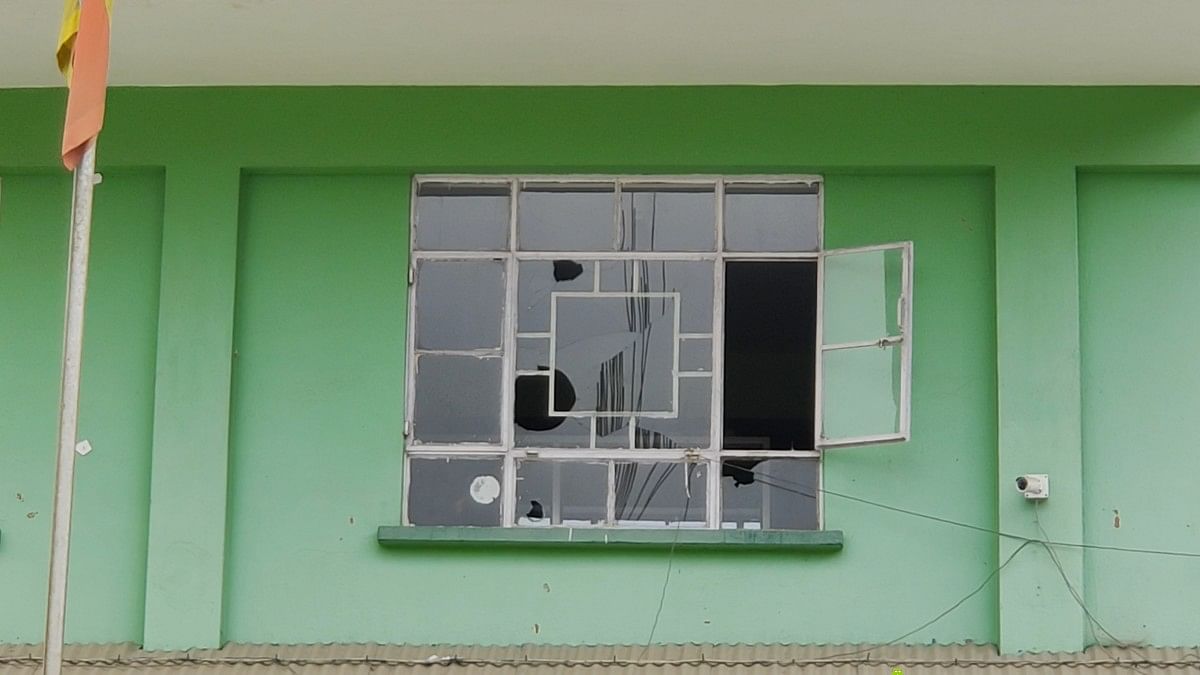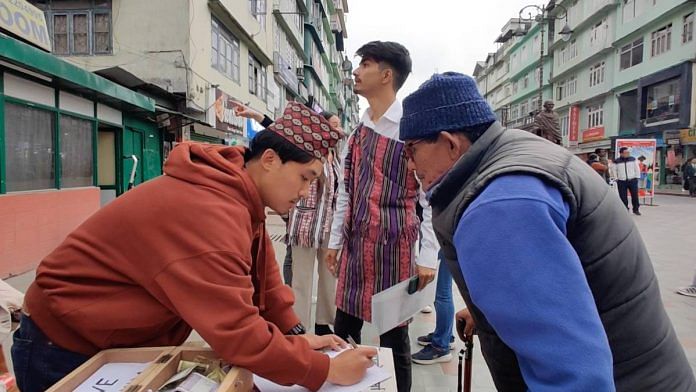Gangtok: The Supreme Court has ordered the removal of the phrase “people of foreign origin” in reference to Sikkimese-Nepalese people from its judgment on tax exemptions delivered on 13 January. But not before the phrase sparked protests in Sikkim.
The apex court was delivering its judgment on a petition filed by the Old Settlers Association of Sikkim seeking tax exemption. The SC’s observation led to protests, strikes, stone pelting and clashes between the ruling Sikkim Krantikari Morcha (SKM) and the Opposition Sikkim Democratic Party (SDF).
This is the first time since 1975 — when the erstwhile kingdom of Sikkim merged with India following a referendum — that the state has witnessed such violent clashes.
Over the past two weeks, the state has seen a number of protests, at least a dozen incidents of stone pelting, and an alleged attack on former chief minister and SDF MLA Pawan Kumar Chamling. Leaders of the ruling party also claim to have faced similar attacks by “hired outsiders”.
With its window and glass panes broken after being pelted with stones, the main office of the SDF wears an almost dilapidated look. When ThePrint visited the office, it was mostly deserted, apart from a few partymen making frantic calls, speaking in Nepali, and sorting through legal documents.

Most SDF members, including party president Chamling, were camped out in another old building, ‘Annex C’, waiting for a party meeting to begin to discuss their next course of action.
“We never thought that would have to move carefully in Sikkim and hide too,” said a senior SDF leader. A video circulating within the party’s office shows unidentified miscreants pelting stones at the office. “The videos are viral now, people should know,” another leader told ThePrint.
Even though the SC has had the specific parts of the judgment — that senior politicians of Sikkim termed “objectionable” and “unfortunate” — removed, the complications and unrest in the state persist, with Sikkim headed for polls next year. The fight is expected to be a bipolar one, between SKM and SDF.
On the issue of the tax exemption, SKM and SDF are at loggerheads. SDF leaders claim that the SC’s decision to strike down the exclusion of old Indian settlers from the Sikkimese population and allow them tax exemption is a move away from the state’s integral special powers.
SDF leaders feel the SKM, which is in alliance with the BJP in the state, is trying to dilute the current status of Sikkim. The state enjoys special status under Article 371F of the Constitution — like J&K did before August 2019 under Article 370.
“Both the observations are problematic. We cannot have the special status of the state be tampered with. The SC has removed the ‘foreign origin’ references. But what about the rest? The inclusion of old settlers into the same tax regime is also a way of altering the existing provisions,” M.K. Subba, senior leader of SDF’s central committee and party’s chief spokesperson, said to ThePrint.
SKM leaders, in response, have said that the SDF’s statements are “tricks” that are being played by Chamling to polarise the people of Sikkim along community lines before the elections.
Talking to ThePrint, Kunga Nima Lepcha, the state’s law and parliamentary affairs minister, said: “The observations by the court were unfortunate. But the Opposition is playing politics over it, while the ruling and Opposition parties should have worked together to ensure the Sikkimese identity is preserved.”
“The state government has taken all kinds of measures to ensure that these kinds of incidents do not occur again. We are also calling a special session of the legislative assembly on 9 February to discuss these issues further and call for a permanent solution. If needed, the full cabinet will reach Delhi as a follow up action to seek a permanent solution,” added the minister, who holds five portfolios.
Also Read: DR Thapa, who led protests against SC’s ‘foreign’ tag for Sikkimese Nepali, is new BJP state chief
‘Identity most critical issue in state like Sikkim’
Assembly elections in Sikkim are scheduled to be held next year. In 2019, after seeing one party rule for 25 years, the state had voted SKM to power. Of the 32 seats, SKM, led by Prem Singh Tamang, had won in 17, while SDF had won in 15.
However, within three months of the election results, 12 SDF MLAs joined the Bharatiya Janata Party (BJP), which was trying to gain a foothold in the state. In October, three seats went to bypoll — BJP bagged two, Tamang won in one. Currently, SDF has one lone MLA in the state — Chamling. He is also the president of SDF.
Following the protests over the ‘foreign origin’ phrase, Chief Minister Prem Singh Tamang, had met senior central ministers Sunday and assured them that the state will file a review petition. The ministry of home affairs (MHA), too, filed a review petition Monday, which resulted in the removal of the observations by the SC Tuesday. The MHA has submitted before SC its position on the sanctity of Article 371F of the Constitution.
In its statement issued on Twitter Monday, the MHA “reiterated” the government of India’s position on “the sanctity of Article 371F of the Constitution that safeguards the Sikkimese identity, which should not be diluted”.
Speaking to ThePrint, Chamling said, “The situation could have been avoided in the first place. Sikkim is probably (sic) the erstwhile kingdom in the continent that held a referendum and joined India as a state. How can a court observe the majority of the state as foreigners? This is the fault of the government, the ruling party. They misled and misdirected the court. Identity is the most critical issue in a state like Sikkim that is geopolitically very sensitive.”
“Sikkim needs a Parliamentary and political solution, which will be permanent. We want the Centre to reassure us that a similar situation or observation by any institution will never come. We will fight for it legally and politically,” he added.
According to the 2011 Census, the Sikkimese Nepalese form 75 per cent of Sikkim’s total population.
The old settlers comprise 400 families, which include around 2,700 individuals in the state of around 6.7 lakh population. Nepalis form 75 per cent of the total population, Lepchas and Bhutias form around 23 per cent, while the old settlers make up around 2 per cent, according to the last census, said Lepcha.
The old settlers feel that the current issue is being played up by both parties for the upcoming elections. A member of the Old Settlers Association, who spoke to ThePrint on condition of anonymity, said: “The petition is 10 years old. We used to give 4 per cent as tax to the state government while the rest of Sikkim residents never paid any tax. We wanted to resolve this disparity and moved the court.”
“However, the series of events and the submissions in the court took place in a way which may make it look like we did something wrong. We just wanted to have our rights. This is about politics and elections. But we are feeling the most insecure here. It had never happened in the past four decades,” added the association member who runs a shop in Gangtok.
Insecurity, demand for ‘permanent status’
The people of Sikkim are feeling insecure as influx from other states has changed its demography to a great extent, said Dr Balaram Pandey, assistant professor of Sikkim University. “There is strong local sentiment. They want their identity to be protected. The state government has a special provision for residents of the erstwhile kingdom called ‘Sikkim Subject’. These residents need to get a Sikkim Subject certificate in order to enjoy their identity as a Sikkimese. The people who have this certificate are considered the indigenous, or original, people of Sikkim,” said Pandey.
“With this observation, the primary worry that comes to the mind is about the fabric of the state. If this issue is not addressed immediately and effectively, this can be India’s biggest worry considering the state’s sensitive location and its proximity to China and Nepal. The influx and the threat to livelihood of people has created an insecurity and the (SC’s) observation fuelled that feeling. With elections next year, both parties will try to gain political benefits from it and this will trigger further trouble,” he added.
In and around MG Marg in central Gangtok, young entrepreneurs and students campaign against the observation and demand ‘permanent status’ so that such observations are never made again.
Adhishree Pradhan, a young entrepreneur told ThePrint: “The observation by the SC calling the indigenous people foreigners has surely hurt us. However, the court has also struck down the definition of Sikkimese, which according to the article 371 F cannot be altered except by the President of India, and that too under special circumstances.”
“Apart from the legal interventions made by the state government, we want to make the people aware of their rights and build a movement to protect our identity and culture,” added Pradhan.
(Edited by Zinnia Ray Chaudhuri)
Also read: ‘Marriage can’t take away identity’: SC order scrapping ‘discriminatory’ tax law for Sikkim women



